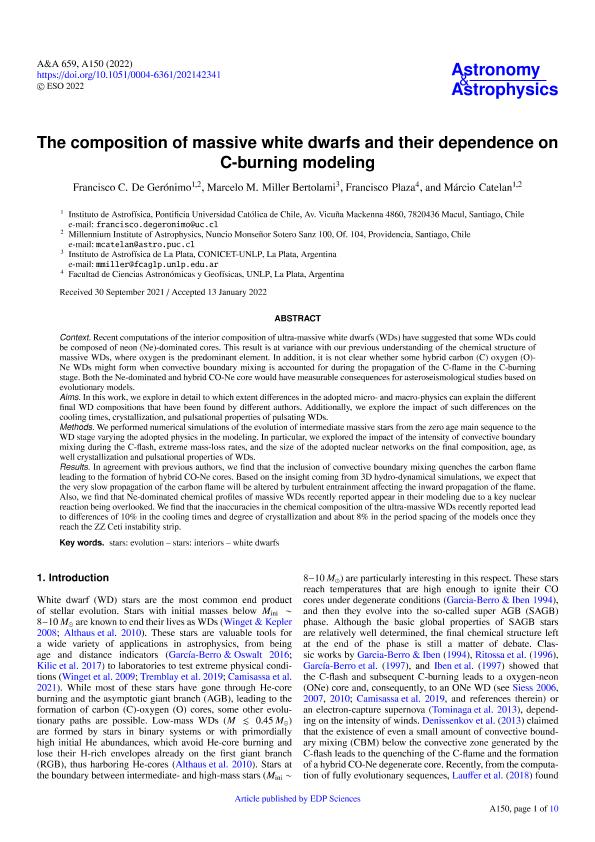Artículo
The composition of massive white dwarfs and their dependence on C-burning modeling
de Gerónimo, Francisco César ; Miller Bertolami, Marcelo Miguel
; Miller Bertolami, Marcelo Miguel ; Plaza, Francisco Ezequiel; Catelan, Márcio
; Plaza, Francisco Ezequiel; Catelan, Márcio
 ; Miller Bertolami, Marcelo Miguel
; Miller Bertolami, Marcelo Miguel ; Plaza, Francisco Ezequiel; Catelan, Márcio
; Plaza, Francisco Ezequiel; Catelan, Márcio
Fecha de publicación:
03/2022
Editorial:
EDP Sciences
Revista:
Astronomy and Astrophysics
ISSN:
0004-6361
Idioma:
Inglés
Tipo de recurso:
Artículo publicado
Clasificación temática:
Resumen
Context. Recent computations of the interior composition of ultra-massive white dwarfs (WDs) have suggested that some WDs could be composed of neon (Ne)-dominated cores. This result is at variance with our previous understanding of the chemical structure of massive WDs, where oxygen is the predominant element. In addition, it is not clear whether some hybrid carbon (C) oxygen (O)-Ne WDs might form when convective boundary mixing is accounted for during the propagation of the C-flame in the C-burning stage. Both the Ne-dominated and hybrid CO-Ne core would have measurable consequences for asteroseismological studies based on evolutionary models. Aims. In this work, we explore in detail to which extent differences in the adopted micro-and macro-physics can explain the different final WD compositions that have been found by different authors. Additionally, we explore the impact of such differences on the cooling times, crystallization, and pulsational properties of pulsating WDs. Methods. We performed numerical simulations of the evolution of intermediate massive stars from the zero age main sequence to the WD stage varying the adopted physics in the modeling. In particular, we explored the impact of the intensity of convective boundary mixing during the C-flash, extreme mass-loss rates, and the size of the adopted nuclear networks on the final composition, age, as well crystallization and pulsational properties of WDs. Results. In agreement with previous authors, we find that the inclusion of convective boundary mixing quenches the carbon flame leading to the formation of hybrid CO-Ne cores. Based on the insight coming from 3D hydro-dynamical simulations, we expect that the very slow propagation of the carbon flame will be altered by turbulent entrainment affecting the inward propagation of the flame. Also, we find that Ne-dominated chemical profiles of massive WDs recently reported appear in their modeling due to a key nuclear reaction being overlooked. We find that the inaccuracies in the chemical composition of the ultra-massive WDs recently reported lead to differences of 10% in the cooling times and degree of crystallization and about 8% in the period spacing of the models once they reach the ZZ Ceti instability strip.
Palabras clave:
STARS: EVOLUTION
,
STARS: INTERIORS
,
WHITE DWARFS
Archivos asociados
Licencia
Identificadores
Colecciones
Articulos(IALP)
Articulos de INST.DE ASTROFISICA LA PLATA
Articulos de INST.DE ASTROFISICA LA PLATA
Citación
de Gerónimo, Francisco César; Miller Bertolami, Marcelo Miguel; Plaza, Francisco Ezequiel; Catelan, Márcio; The composition of massive white dwarfs and their dependence on C-burning modeling; EDP Sciences; Astronomy and Astrophysics; 659; A150; 3-2022; 1-10
Compartir
Altmétricas



